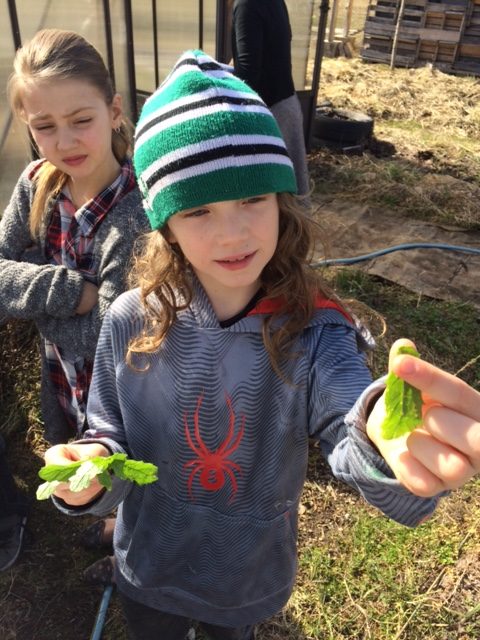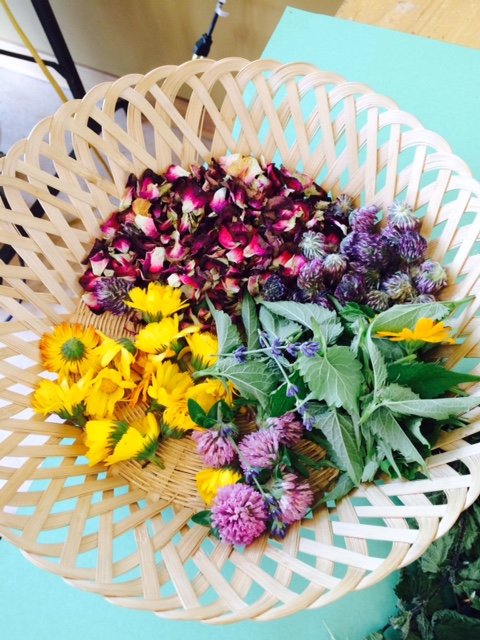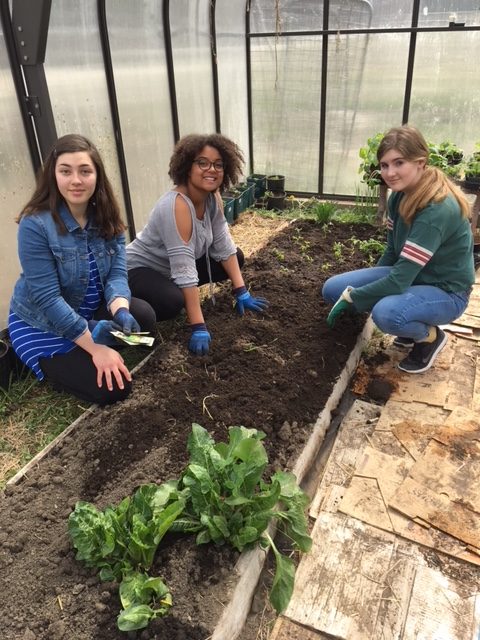Crawford Bay Elementary School, Crawford Bay, BC
2017-2018 (Year 2)
In our rural K-12 school in the Kootenay region of British Columbia, many students have created a special relationship with their garden. One of the contributing factors has been that all plants have been started by seed and were planted by the students themselves. Working by the biodynamic growing calendar, students planted a large number of their seeds on the new moon that honored the Chinese New Year on February 16, 2018.
Being able to observe their seeds grow under grow lights each time they entered the French/Visual Arts room allowed our Gr. 4-6 students to build and maintain a relationship with their plants. After planting tomato seeds, and transplanting them into the greenhouse with an older buddy as an Earth Day activity, students used these plants as subjects for a blind contour art lesson. As they have watered them in the greenhouse students have shared in the success of their growth. Along with their herb garden shaped like a pizza and planted in slices, one can only image what the value of eating these tomatoes will be for students.
The grain required for the flour to make a pizza crust is where the Kindergarten-Gr. 2 social studies students come in. Studying ancient civilizations and the importance of agricultural practices and animal domestication, the Kindergarten-Gr. 2 students have learned how to broadcast plant barley and wheat berries. Singing and drumming indigenous songs of support, students have come to understand how to grow wheat and the importance of looking after a crop of their own. The educational hands-on learning and fun will continue with the grain harvest, threshing and milling of the wheat in the fall.
Another area of importance in the garden in the Medicine Wheel garden planted this year by the French 10/11 students. Students have practiced French vocabulary and verb conjugation during the planting, weeding, watering and harvesting of their plants. Given a hands on experience of understanding more about indigenous culture, students have learned how to braid sweet grass, learned the significance of this medicine, and have gifted their first braids to someone special. Harvesting mint, nettles, lemon balm, lavender and rose petals for tisanes has also encouraged the positive on-going relationship students have with the plants in the garden.
To complete the year, visual arts students have built toad homes to encourage toads to move into the garden and care take over the summer months when the students will be away. Science-based learning has taken place in this area as well as students using their hand-building skills in clay to design unique and creative homes for the toads.
As I taught a Grade 5 student how to gather garlic flowers for a salad we shared together, I reflected on the value of such a positive and unique educational relationship students have cultivated with the garden and what a testament this was to the importance of developing school gardens in all schools. The connection to the earth, the seasons, the weather and temperature has also had a significant impact on students. Thank you again to Farm to School for the support to develop so many integrated cross-curricular educational programs in our school.
Shannon Lanaway
Co-Garden Learning Coordinator
Crawford Bay Elementary-Secondary School
2016-2017 (Year 1)
 One of the first things I noticed about Crawford Bay School was the focus on food. During my first month as principal in 2015, I was in the school garden during a primary class activity and students were gleefully eating arugula from the greenhouse. One little boy was stuffing his pockets full of the greens so that he could have a treat on the school bus ride home. Last year I could count on having some kind of weekly soup made by the elementary students after their foray into the garden, and if we were lucky there would also be some kind of fruit crisp to go along with it. We had school-grown pumpkins at Halloween, which we then turned into soup and roasted seeds. Nasturtium flowers decorate our salads at lunch, and kale and chard are mixed into whatever is on the menu for hot lunch. Elementary students package up herbal tea mixes and watch their seeds starting in the spring with hawk-like eyes. In short, Crawford Bay School likes growing good food.
One of the first things I noticed about Crawford Bay School was the focus on food. During my first month as principal in 2015, I was in the school garden during a primary class activity and students were gleefully eating arugula from the greenhouse. One little boy was stuffing his pockets full of the greens so that he could have a treat on the school bus ride home. Last year I could count on having some kind of weekly soup made by the elementary students after their foray into the garden, and if we were lucky there would also be some kind of fruit crisp to go along with it. We had school-grown pumpkins at Halloween, which we then turned into soup and roasted seeds. Nasturtium flowers decorate our salads at lunch, and kale and chard are mixed into whatever is on the menu for hot lunch. Elementary students package up herbal tea mixes and watch their seeds starting in the spring with hawk-like eyes. In short, Crawford Bay School likes growing good food.
Our community is home to a number of people who are committed to growing food and promoting local, healthy produce. Volunteers many years ago set up a healthy hot lunch program, built a school garden, and received a Farm to School grant to provide start up equipment. Fast forward several years, to when I arrived in May 2015, and there continues to be a daily hot lunch program run by PAC, complete with a salad, soup, and hot entrée, as well as a garden with a number of beds and greenhouse. The foundations were in place when I arrived for growing and eating healthy, local food, but there were still a number of challenges. This is when we applied for another Farm to School grant and began work on the next phase: increasing the amount of locally grown food in our hot lunch program, and increasing the amount of “garden-learning” across the curriculum.
 We are a remote community and in order to acquire enough locally grown food for a school hot lunch program we have to go beyond our community to the nearest town, Creston. The challenges with this involve transportation, storage, and cost. Having a daily hot lunch program has financial challenges, and when the goal is to include as much locally grown food as possible, it becomes even more difficult. Building capacity in staff is also required in order to integrate the garden across the school, and get older students excited about it. It isn’t an easy task. However, we are committed to working towards this and know that over time we will succeed. Many thanks to Farm to School for supporting us in this work!
We are a remote community and in order to acquire enough locally grown food for a school hot lunch program we have to go beyond our community to the nearest town, Creston. The challenges with this involve transportation, storage, and cost. Having a daily hot lunch program has financial challenges, and when the goal is to include as much locally grown food as possible, it becomes even more difficult. Building capacity in staff is also required in order to integrate the garden across the school, and get older students excited about it. It isn’t an easy task. However, we are committed to working towards this and know that over time we will succeed. Many thanks to Farm to School for supporting us in this work!
Crawford Bay Elementary-Secondary School
16159 Walkley Road
Crawford Bay, BC
V0B 1E0
67 students from K-12





